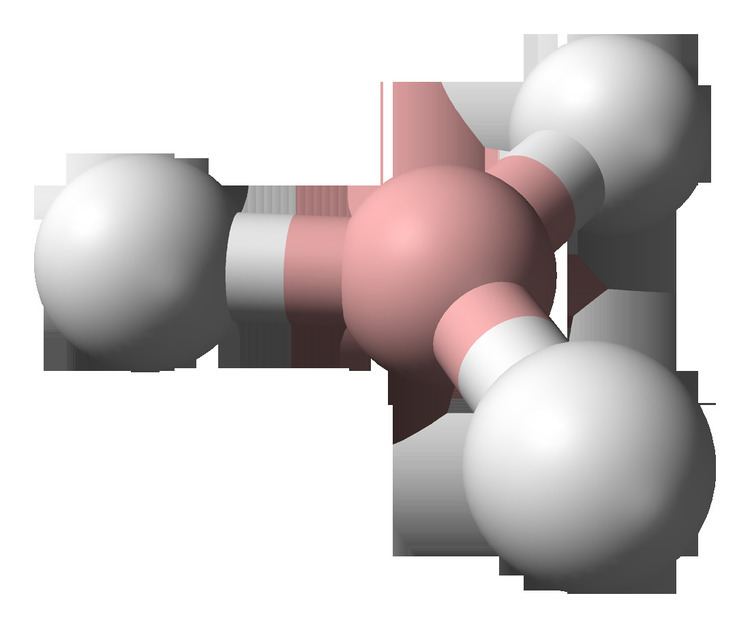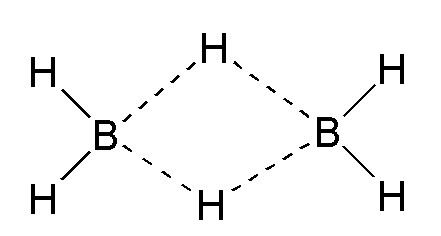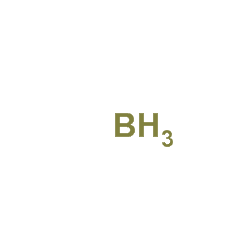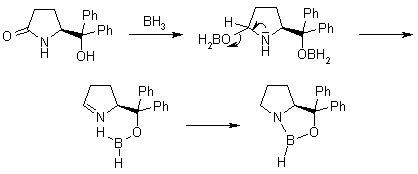Related compounds | Appearance colourless gas | |
 | ||
Borane (also systematically named trihydridoboron), also called borine, is an inorganic compound with the chemical formula BH
3. It is a colourless gas that cannot be concentrated in pure form. Borane is both the simplest member of the boranes, and the prototype of the monoboranes.
Contents
- Bonding in highr boranes che
- History
- Preparation of molecular BH3
- Structure
- Amphotericity
- Borane as a reactive intermediate
- Solute properties of diborane
- Production
- Uses
- References

Bonding in highr boranes che
History

In 1937, the discovery of carbonyltrihydridoboron, the adduct of borane with carbon monoxide, among other borane adducts, played an important role in exploring the chemistry of "normal" boranes at a time when three-centre two-electron bonding was not yet known. This discovery also implied the existence of borane, however, it was not until some years later that direct evidence was observed.
Preparation of molecular BH3

The matrix isolated products of laser ablated boron atoms with hydrogen forms BH3 as a minor constituent along with B2H6, diborane and BH(H2) complex. Studies of gas phase diborane have detected monomeric BH3.
Structure

The structure of BH3 is trigonal planar (D3h molecular symmetry) with an experimentally determined B–H bond length of 119 pm. This the same as the terminal B–H bond length in diborane(6). The dominant behaviour of borane is its dimerisation to form diborane, as shown by the enthalpy of the reaction, which is predicted to be near -40 kcal/mol. For such an exothermic process, the concentration of BH3 is negligible in solution.
2 BH3 → B2H6Amphotericity
Although borane in principle acts as a Lewis acid, the many 1:1 adducts are invariably prepared from diborane or via ligand exchange of an existing adduct.
B2H6 + 2 L → 2 LBH3The stability sequence of these estimated spectroscopically and thermochemically is:-
PF3 < CO < Et2O < Me2O < C4H8O < C4H8S < Et2S < Me2S < Py < Me3N < H−BH3 has some soft acid characteristics (sulfur donors are more stable than oxygen donors).
The boryl group (-BH
2) in boranes such as borane can assimilate another hydrogen centre into the molecule by ionisation:
3 + H+
→ BH
2(H
2)+
Because of this capture of the proton (H+
), borane has basic character. Its conjugate acid is (η-dihydrogen)dihydridoboron(1+) ([BH
2(η-H
2)]+). It should be noted that being a Kubas complex, [BH
2(η-H
2)]+ rapidly decomposes and ejects dihydrogen. Borane does not form stable aqueous solutions due to hydrolysis.
3 + 3 H
2O
3 + 3 H
2
Borane as a reactive intermediate
One example where molecular BH3 is believed to be a reaction intermediate is in the pyrolysis of diborane to produce higher boranes:
B2H6 ⇌ 2BH3BH3 +B2H6 → B3H7 +H2 (rate determining step)BH3 + B3H7 ⇌ B4H10B2H6 + B3H7 → BH3 + B4H10Further steps give rise to successively higher boranes, with B10H14 as the most stable end product contaminated with polymeric materials, and a little B20H26.
Another example is hydroboration reaction, in which "diborane" adds to an alkene. In this reaction, either the diborane dissociates forming BH3 as an intermediate or one B–H–B bridge opens to produce an electron deficient boron atom. The addition to alkenes is rapid, quantitative and reversible. The addition is anti-Markovnikov, that is to say that boron adds to the less substituted C atom, the attack taking place on the less hindered side of the molecule.
Solute properties of diborane
Diborane dissolves in diethyl ether and diglyme and is present as the dimer. In Tetrahydrofuran, THF, it is present as a loose 1:1 adduct, THF•BH3. A diborane solution in THF is commercially available as is a solution of the DMS complex. Gaseous borane, diborane(6) dissolves in polar compounds such as amines and tetrahydrofuran. This dissolution property of diborane makes it a widely used laboratory chemical, for example, as a reagent in the production of ethylborane. Borane is commercially available as a Lewis acid–base adduct with various ligands, including solutions of borane dimethylsulfide, ammonia borane (and other amines), and borane tetrahydrofuran. Borane has a solubility in liquid ammonia of 3.2 mol L−1, above which it precipitates out as the ammoniate. Any attempt to deammoniate the crystallised product thermally, only results in its decomposition.
Production
There are two main methods for producing borane. One common method is the cleaving reaction of diborane with dimethyl sulfide. The other method is the partial oxidation of a boranuide salt under a coordinating borane solvent such as trimethylamine.
Uses
Borane adducts are widely used in organic synthesis for hydroboration, where BH3 adds across the C=C bond in alkenes to give trialkylboranes:
(THF)BH3 + 3 CH2=CHR → B(CH2CH2R)3 + THFThis reaction is regioselective, and the product trialkylboranes can be converted to useful organic derivatives. With bulky alkenes one can prepare species such as [HBR2]2, which are also useful reagents in more specialised applications. Borane dimethylsulfide which is more stable than the THF adduct of borane adduct.
